Flowers are versatile and come in every color of the rainbow, but some are particularly bizarre. Tucked away in obscure corners of the globe, these plants aren’t likely to show up in your landscapes anytime soon. Just to show you just how crazy various flora can look, here are some of the weirdest flowers we could find:
-
Monkey Face Orchid

this little guy didn’t take a whole lot of imagination to name “Dracula” because of it’s too long and fang-like petals. The two dark little eyes, fuzzy dotted eyebrows, and a furry little nose and beard area bear striking simian resemblances that become even more obvious when viewed from a distance. This Monkey Face Orchid is very rare to found. It is only found in the cloud forests of Peru and southeastern Ecuador at altitudes of more than 3,000 feet. It has the ability to bloom all year round and its flowers smell like ripe oranges
2. Moth orchid
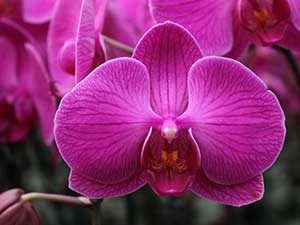
The Moth Orchid is actually the most common type of orchid and bears the name because of its supposed resemblance to a moth in flight. Native to southeast Asia, the Philippines, and northern Australia, the Moth Orchid isn’t exactly hard to find and it comes in nearly every color of the rainbow.
3. Naked Man orchid
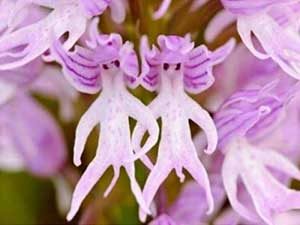
This little guy also known as the Hanging Man Orchid, is native to the Mediterranean regions and resemble tiny little hanging naked men, from their dotted eyes and smiles right down to their you-know-what. Naked Man Orchids come in all sizes and usually range in color from light purplish white to deep purply-pink.
4. Orchid That Looks Like A Ballerina
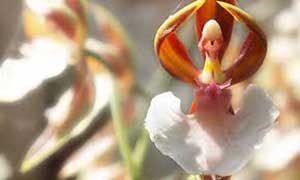
These little plants are a species of orchids that stretch on the earth, growing either individually or in groups in different areas of Australia. The flowers are usually brown with brown markings in the shape of a girl dressed in a white tutu that positively poses as a ballerina. Unfortunately, animals living in the area, such as rabbits and kangaroos, are a real danger to these flowering flowers.
5. Parrot Flower
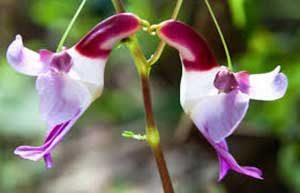
The Parrot Flower, a Thailand native, is classified as endangered and therefore not allowed to leave the country. The cool thing about the flower of this rare species of balsam is that when you look at its side profile, it looks just like a parrot or cockatoo in flight.
6. Passion Flower
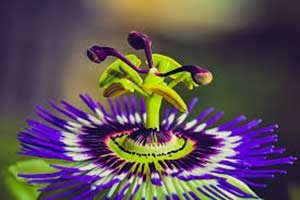
The Passion Flower has more than 400 different varieties and is known as the Clock Flower in India and Japan. When it was first encountered by Spanish missionaries it was given its name because of its likeness to elements in the story of Jesus’s crucifixion which is also called “The Passion”. The Passion Flower produces an amazing scent that’s used commercially as well as a tasty fruit, which is used in flavorings for a number of different culinary dishes.
7. Pleurothallis truncate
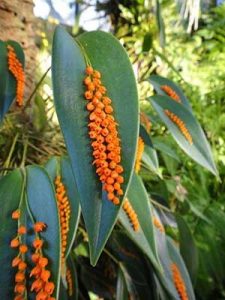
The flowers look like horizontal, orange Lily of the Valley, but they are actually a member of the orchid family. They are part of the Pleurothallis genus to be exact, also called Bonnet Orchids for their tiny blooms’ resemblance to little baby bonnets. They can grow in a variety of different ways, as brush cover, as climbers, clumped and trailing, or as tall cane-like plants. Unlike regular orchids, these orchids prefer cooler temperatures and low moisture; they grow most comfortably at very high altitudes.
8. Protea Pinwheel
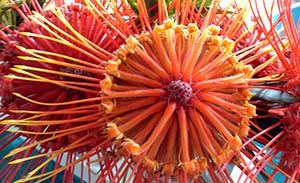
This fun flower looks more like a carnival toy than a creation of nature. Also known as the Catherine-wheel Pincushion flowers. The coolest fact about this flower is that it’s interconnected with fire. In the wild, Protea Pinwheels are perfectly suited to adapt to harsh climates. The best time for Protea Pinwheels to bloom is after a fire, when the adult plants, rodents, and other insects that would impede their growth have been destroyed.
9. Silver Vase
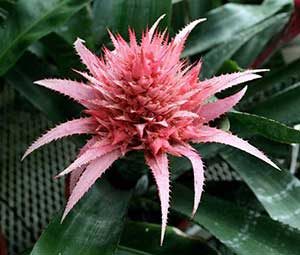
This prestigious plant is native to Brazil and has garnered the Royal Horticultural Society’s Award of Garden Merit for its quality and growability. Even those with without green thumbs should be able to grow the Silver Vase plant. The Silver Vase is a slow grower with broad, waxy leaves and sharp, spiky flower heads. Once the pink flower has finished blooming, the silvery striped leaves will begin to die.
10. Snake Gourd Flower
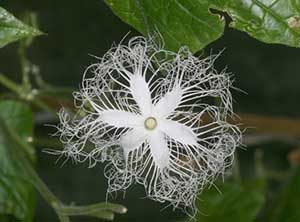
The beautiful Snake Gourd flower may look like it belongs on a festively wrapped present, but it’s actually a vegetable! The Snake Gourd originated as a wild vegetable that grew in India, but these days it is cultivated around the world. It’s a member of the pumpkin family. The Snake Gourd flower is used in a variety of different medical applications, and the reddish fruit inside an overly-ripe gourd can also be used as a tomato substitute when cooking.
11. Snap Dragon Seed Pod
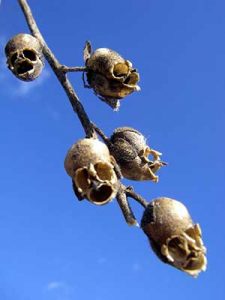
Many gardeners and horticulturists are fond of Snapdragons for their bright colors and fragrance. If you squeeze the sides of a Snapdragon flower it looks like a dragon’s mouth opening and closing but not so many gardeners and horticulturists know about the dragon skulls that are left once the Snapdragon has gone to seed.
12. Spider Chrysanthemum
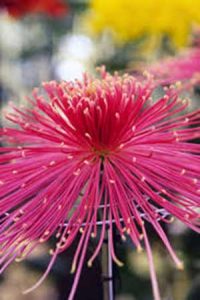
the Spider Chrysanthemum is a favorite flower of florists and gardeners alike. Like all other mums, the Spider Chrysanthemum is well-suited for patio or container gardening. To keep your Spider Mums blooming for as long as you can, be sure to remove faded blooms and tightly closed buds to encourage new flowering. Another trick to having the biggest, best blooms is to keep them out of direct sunlight while they are flowering. This will not only extend total bloom time, but it will also help the flowers last longer in general.
13. Star Flower
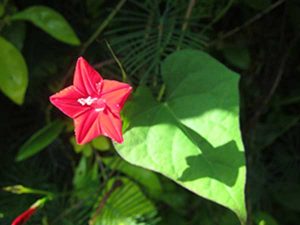
The Star Flower also is known as the starfish flower. It is another carrion plant. Sought by plant collectors and gardeners because of its unique, striking appearance and large fuzzy flowers, this is a plant that is best kept outside. The color of this plant’s flowers can range from deep reds and purples to lighter pinks, mauves, and yellow. Its touchable, hairy, leathery flower may draw you in but its disgusting scent will send you running for the hills.
14. Subterranean Plant
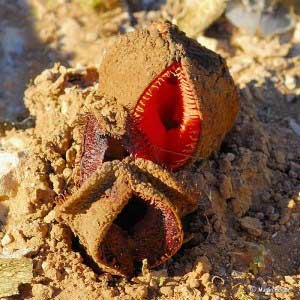
This south African subterranean plant is truly one of the most bizarre plants on Earth. Despite its crazy look, it’s actually semi-common in the arid regions of southern Africa. The Hydnora Africana, also called Jackal Food by the locals, has no visible leaves, roots or chlorophyll. It is strictly a parasitic, underground plant whose flowers take nearly one year to emerge from the ground.
15. Swaddled-Babies
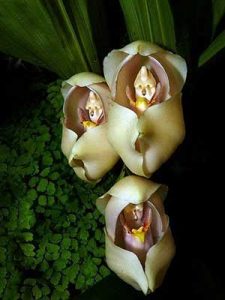
These tulip orchids, nicknamed Swaddled Babies, were discovered in the Colombian Andes between 1777-1788 during a ten-year expedition, but weren’t named and officially classified until 1798. During certain times of the plant’s blooming stage, the flowers’ unique shapes resemble that of a baby all wrapped up in white swaddling. Their tempting scent attracts insects to the hinged lip of the petal where the unsuspecting creatures are shoved into the column, where a pack of pollen then attaches itself to their abdomens, increasing pollination.
16. Tiger face in Moon Orchid
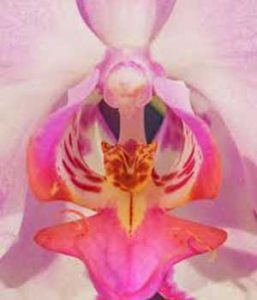
The moon orchid is one of Indonesia’s three national flowers the flower of charm, the other two are Jasminum sambac and Rafflesia arnoldii. Usually, in nature, the stripings and markings on flowers are evolved to either mimic larger animals in order to scare away predators, or to resemble the genitals of insects in order to attract the largest number of pollinators and propagate. The Moon Orchid’s stripes look almost exactly like that of a tiger.
17. Tropical pitcher plant
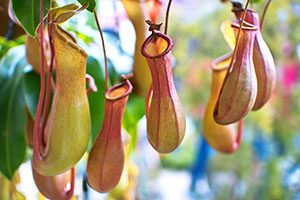
Tropical pitcher plants, also called Monkey Cups by those familiar with the species, can be found in many places throughout the world from Madagascar to Australia, but they’re most common in the jungles of Indonesia. These fanciful flowers look like you can walk up and take a drink right from them, but that’s the last thing you’ll want to do. In fact, the tropical Pitcher Plants are carnivorous climbers, luring in unsuspecting insects with sweet nectar that is then trapped in the goblet-like cup and unable to escape.
18. Virgin Mary in Moon Orchid
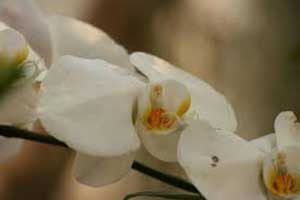
This coastal-loving orchid comes almost exclusively in white and glitters as if covered in frost when the sunlight hits it. At first, it appears to be a common Moth Orchid, but upon closer inspection, it looks like a teeny carving of the Catholic Madonna has been placed inside. Something you may not know about the Virgin Orchid is that it makes an excellent home for ants.
19. Voodoo Lily
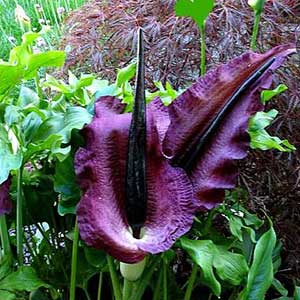
Native to Europe and the Balkans, the Voodoo Lily is indeed an evil looking plant. The part that gets the most attention is its deep purple “flower”. This “flower” is not an actual flower, but a spathe, like on the Calla Lily. The purple flower only lasts about three to four days and reveals a dark seed cob after it withers and falls off. Despite its tropical appearance, the Voodoo Lily is quite hard and can survive in most climates.
20. Welwitschia
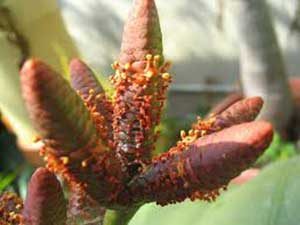
At first glance, it looks like this little plant’s got a fungus on its flowers, but that’s actually the way it is supposed to look. Another true one-of-a-kind flower on our list, the Welwitschia Mirabilis is the only member of the Welwitschiaceae family. It could be considered the Methuselah of plants; it’s been around since the Jurassic Era and in some instances can live to a ripe old age of 1,500 years.
21. White Egret Orchid
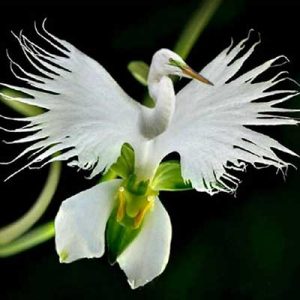
One of the most delicate, intricate of the orchids, the White Egret Orchid looks almost exactly like a White Egret in full flight. The White Egret Orchid is the most distinctive of the orchids and is extremely popular with plant collectors and gardeners alike. A wild orchid variety, the White Egret Orchid flourishes in Asia and has also proven to successfully flourish in the United States as well. The flying bird-like flowers grow along a single spike, and a single spike can yield up to ten individual flowers and has the ability to grow up to sixteen inches tall

